Orexin Receptor: Structure, Drug Targeting and Therapeutic Use for Insomnia
VerifiedAdded on 2023/06/10
|8
|1941
|443
AI Summary
This report covers the structure of Orexin receptors and the drug Daridorexant that targets them to treat insomnia. The report discusses the evidence for the drug's use as a therapeutic agent and its mechanism of action. The Orexin receptor is a G-Protein-Coupled receptor that binds the neuropeptide Orexin. Daridorexant blocks the binding of Orexin to Orexin type 1 and 2 receptors, inhibiting the wake drive. Clinical trials have shown that Daridorexant effectively treats insomnia.
Contribute Materials
Your contribution can guide someone’s learning journey. Share your
documents today.

Pharmacy
Secure Best Marks with AI Grader
Need help grading? Try our AI Grader for instant feedback on your assignments.
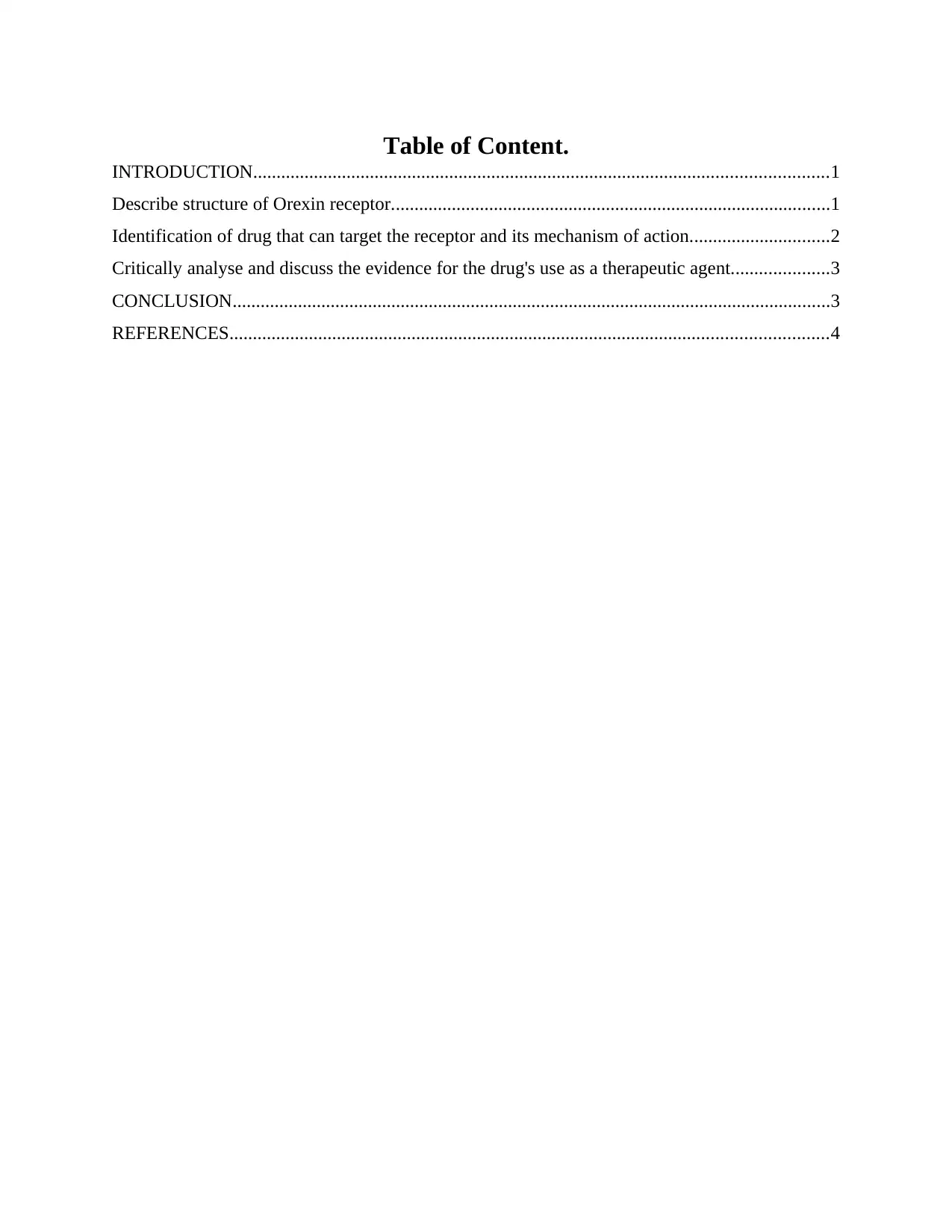
Table of Content.
INTRODUCTION...........................................................................................................................1
Describe structure of Orexin receptor..............................................................................................1
Identification of drug that can target the receptor and its mechanism of action..............................2
Critically analyse and discuss the evidence for the drug's use as a therapeutic agent.....................3
CONCLUSION................................................................................................................................3
REFERENCES................................................................................................................................4
INTRODUCTION...........................................................................................................................1
Describe structure of Orexin receptor..............................................................................................1
Identification of drug that can target the receptor and its mechanism of action..............................2
Critically analyse and discuss the evidence for the drug's use as a therapeutic agent.....................3
CONCLUSION................................................................................................................................3
REFERENCES................................................................................................................................4
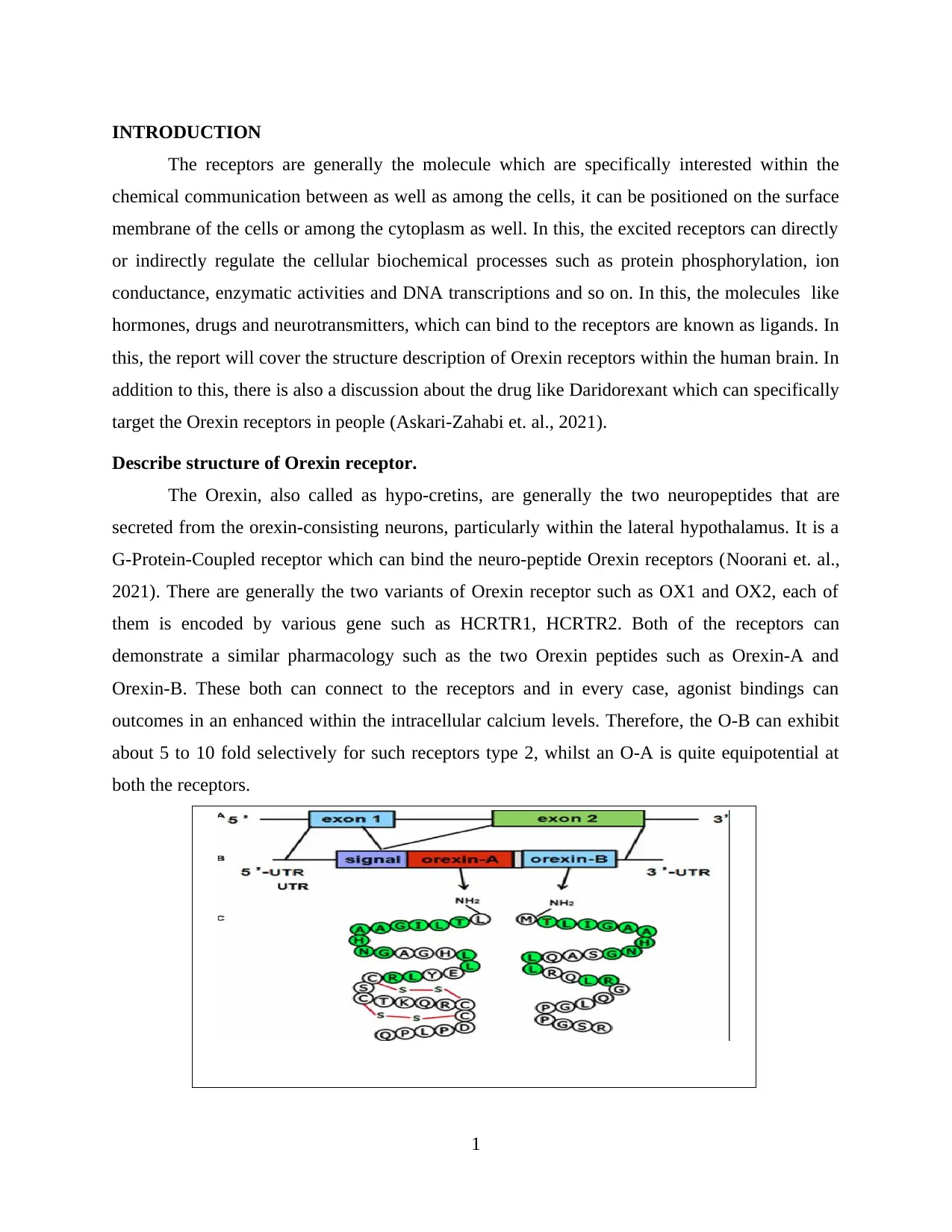
INTRODUCTION
The receptors are generally the molecule which are specifically interested within the
chemical communication between as well as among the cells, it can be positioned on the surface
membrane of the cells or among the cytoplasm as well. In this, the excited receptors can directly
or indirectly regulate the cellular biochemical processes such as protein phosphorylation, ion
conductance, enzymatic activities and DNA transcriptions and so on. In this, the molecules like
hormones, drugs and neurotransmitters, which can bind to the receptors are known as ligands. In
this, the report will cover the structure description of Orexin receptors within the human brain. In
addition to this, there is also a discussion about the drug like Daridorexant which can specifically
target the Orexin receptors in people (Askari-Zahabi et. al., 2021).
Describe structure of Orexin receptor.
The Orexin, also called as hypo-cretins, are generally the two neuropeptides that are
secreted from the orexin-consisting neurons, particularly within the lateral hypothalamus. It is a
G-Protein-Coupled receptor which can bind the neuro-peptide Orexin receptors (Noorani et. al.,
2021). There are generally the two variants of Orexin receptor such as OX1 and OX2, each of
them is encoded by various gene such as HCRTR1, HCRTR2. Both of the receptors can
demonstrate a similar pharmacology such as the two Orexin peptides such as Orexin-A and
Orexin-B. These both can connect to the receptors and in every case, agonist bindings can
outcomes in an enhanced within the intracellular calcium levels. Therefore, the O-B can exhibit
about 5 to 10 fold selectively for such receptors type 2, whilst an O-A is quite equipotential at
both the receptors.
1
The receptors are generally the molecule which are specifically interested within the
chemical communication between as well as among the cells, it can be positioned on the surface
membrane of the cells or among the cytoplasm as well. In this, the excited receptors can directly
or indirectly regulate the cellular biochemical processes such as protein phosphorylation, ion
conductance, enzymatic activities and DNA transcriptions and so on. In this, the molecules like
hormones, drugs and neurotransmitters, which can bind to the receptors are known as ligands. In
this, the report will cover the structure description of Orexin receptors within the human brain. In
addition to this, there is also a discussion about the drug like Daridorexant which can specifically
target the Orexin receptors in people (Askari-Zahabi et. al., 2021).
Describe structure of Orexin receptor.
The Orexin, also called as hypo-cretins, are generally the two neuropeptides that are
secreted from the orexin-consisting neurons, particularly within the lateral hypothalamus. It is a
G-Protein-Coupled receptor which can bind the neuro-peptide Orexin receptors (Noorani et. al.,
2021). There are generally the two variants of Orexin receptor such as OX1 and OX2, each of
them is encoded by various gene such as HCRTR1, HCRTR2. Both of the receptors can
demonstrate a similar pharmacology such as the two Orexin peptides such as Orexin-A and
Orexin-B. These both can connect to the receptors and in every case, agonist bindings can
outcomes in an enhanced within the intracellular calcium levels. Therefore, the O-B can exhibit
about 5 to 10 fold selectively for such receptors type 2, whilst an O-A is quite equipotential at
both the receptors.
1
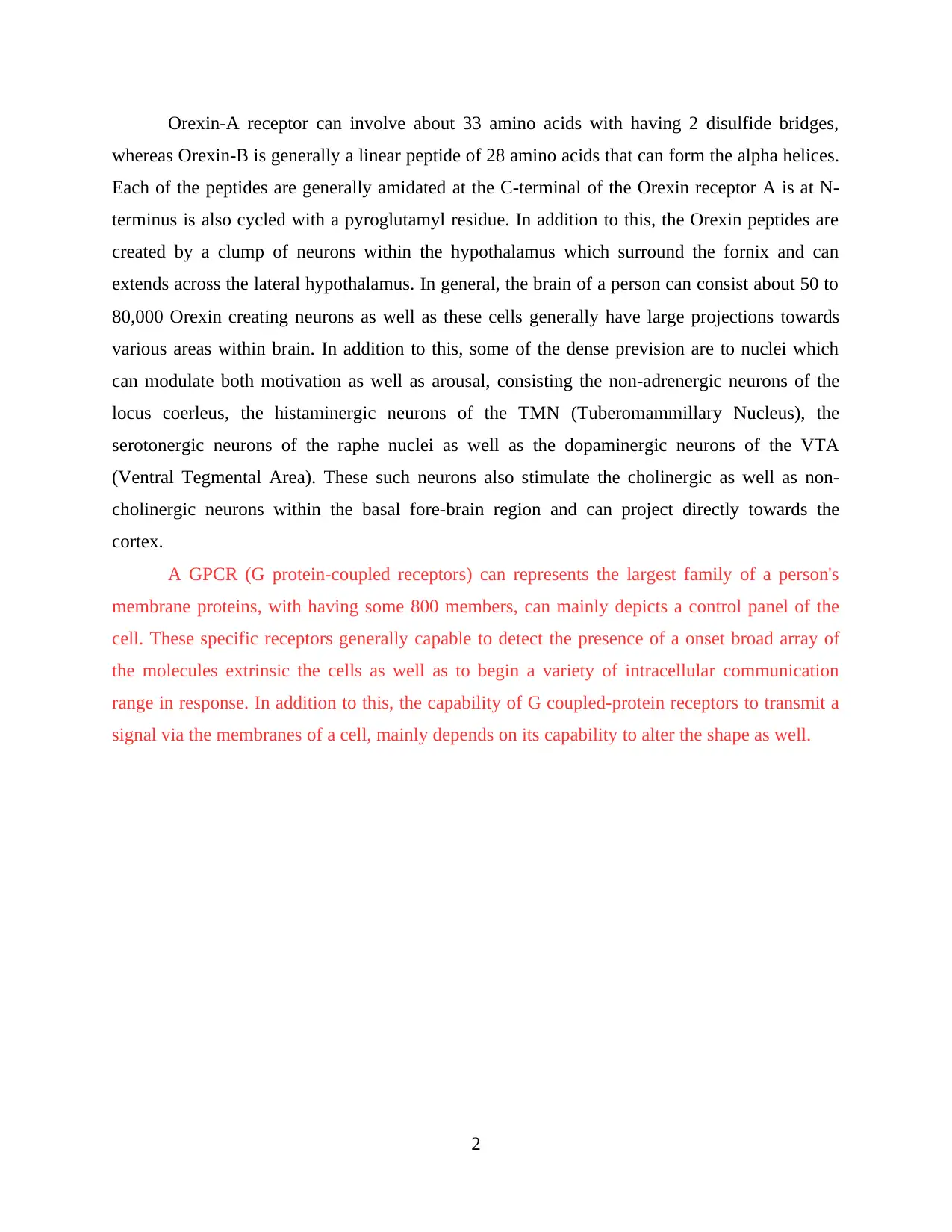
Orexin-A receptor can involve about 33 amino acids with having 2 disulfide bridges,
whereas Orexin-B is generally a linear peptide of 28 amino acids that can form the alpha helices.
Each of the peptides are generally amidated at the C-terminal of the Orexin receptor A is at N-
terminus is also cycled with a pyroglutamyl residue. In addition to this, the Orexin peptides are
created by a clump of neurons within the hypothalamus which surround the fornix and can
extends across the lateral hypothalamus. In general, the brain of a person can consist about 50 to
80,000 Orexin creating neurons as well as these cells generally have large projections towards
various areas within brain. In addition to this, some of the dense prevision are to nuclei which
can modulate both motivation as well as arousal, consisting the non-adrenergic neurons of the
locus coerleus, the histaminergic neurons of the TMN (Tuberomammillary Nucleus), the
serotonergic neurons of the raphe nuclei as well as the dopaminergic neurons of the VTA
(Ventral Tegmental Area). These such neurons also stimulate the cholinergic as well as non-
cholinergic neurons within the basal fore-brain region and can project directly towards the
cortex.
A GPCR (G protein-coupled receptors) can represents the largest family of a person's
membrane proteins, with having some 800 members, can mainly depicts a control panel of the
cell. These specific receptors generally capable to detect the presence of a onset broad array of
the molecules extrinsic the cells as well as to begin a variety of intracellular communication
range in response. In addition to this, the capability of G coupled-protein receptors to transmit a
signal via the membranes of a cell, mainly depends on its capability to alter the shape as well.
2
whereas Orexin-B is generally a linear peptide of 28 amino acids that can form the alpha helices.
Each of the peptides are generally amidated at the C-terminal of the Orexin receptor A is at N-
terminus is also cycled with a pyroglutamyl residue. In addition to this, the Orexin peptides are
created by a clump of neurons within the hypothalamus which surround the fornix and can
extends across the lateral hypothalamus. In general, the brain of a person can consist about 50 to
80,000 Orexin creating neurons as well as these cells generally have large projections towards
various areas within brain. In addition to this, some of the dense prevision are to nuclei which
can modulate both motivation as well as arousal, consisting the non-adrenergic neurons of the
locus coerleus, the histaminergic neurons of the TMN (Tuberomammillary Nucleus), the
serotonergic neurons of the raphe nuclei as well as the dopaminergic neurons of the VTA
(Ventral Tegmental Area). These such neurons also stimulate the cholinergic as well as non-
cholinergic neurons within the basal fore-brain region and can project directly towards the
cortex.
A GPCR (G protein-coupled receptors) can represents the largest family of a person's
membrane proteins, with having some 800 members, can mainly depicts a control panel of the
cell. These specific receptors generally capable to detect the presence of a onset broad array of
the molecules extrinsic the cells as well as to begin a variety of intracellular communication
range in response. In addition to this, the capability of G coupled-protein receptors to transmit a
signal via the membranes of a cell, mainly depends on its capability to alter the shape as well.
2
Secure Best Marks with AI Grader
Need help grading? Try our AI Grader for instant feedback on your assignments.
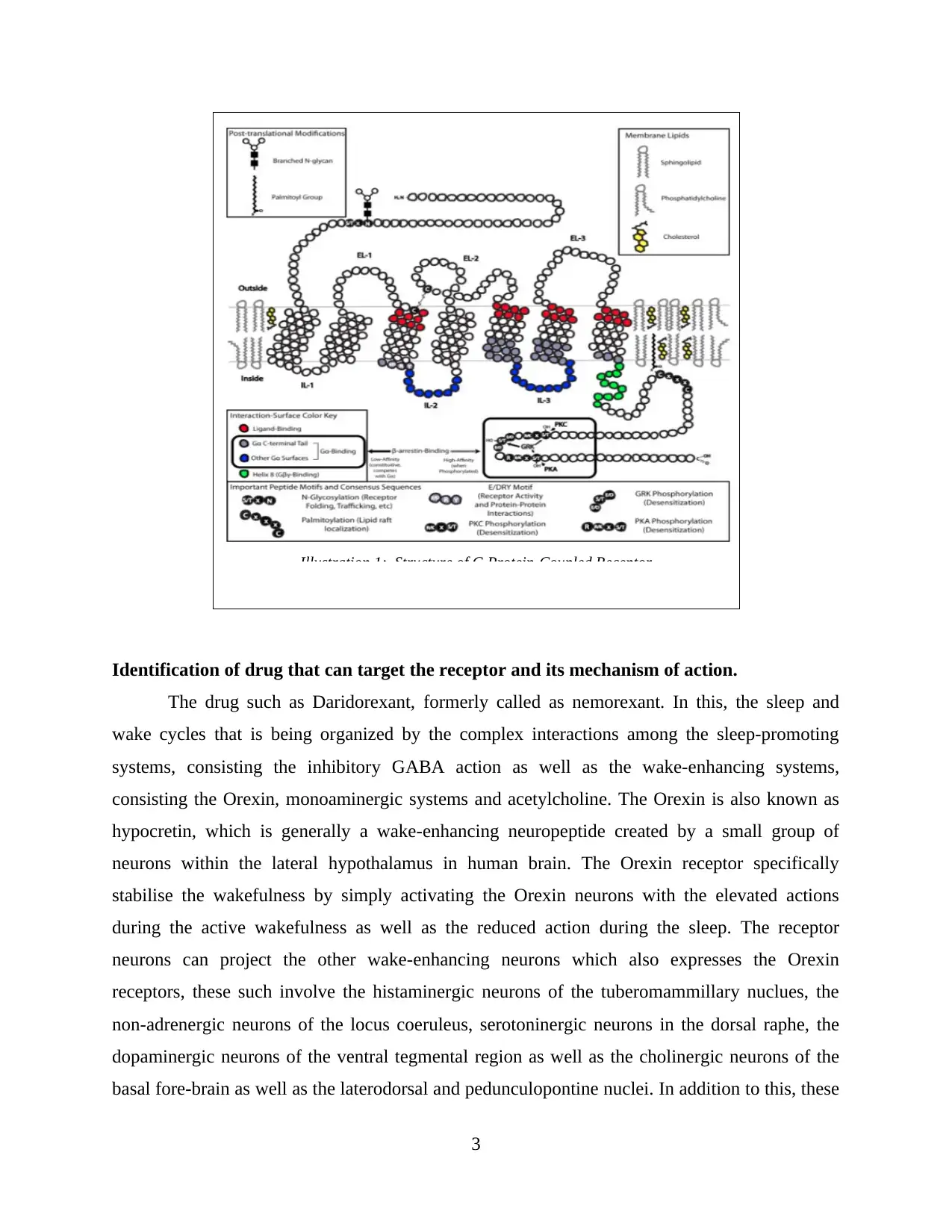
Identification of drug that can target the receptor and its mechanism of action.
The drug such as Daridorexant, formerly called as nemorexant. In this, the sleep and
wake cycles that is being organized by the complex interactions among the sleep-promoting
systems, consisting the inhibitory GABA action as well as the wake-enhancing systems,
consisting the Orexin, monoaminergic systems and acetylcholine. The Orexin is also known as
hypocretin, which is generally a wake-enhancing neuropeptide created by a small group of
neurons within the lateral hypothalamus in human brain. The Orexin receptor specifically
stabilise the wakefulness by simply activating the Orexin neurons with the elevated actions
during the active wakefulness as well as the reduced action during the sleep. The receptor
neurons can project the other wake-enhancing neurons which also expresses the Orexin
receptors, these such involve the histaminergic neurons of the tuberomammillary nuclues, the
non-adrenergic neurons of the locus coeruleus, serotoninergic neurons in the dorsal raphe, the
dopaminergic neurons of the ventral tegmental region as well as the cholinergic neurons of the
basal fore-brain as well as the laterodorsal and pedunculopontine nuclei. In addition to this, these
3
Illustration 1: Structure of G Protein-Coupled Receptor
The drug such as Daridorexant, formerly called as nemorexant. In this, the sleep and
wake cycles that is being organized by the complex interactions among the sleep-promoting
systems, consisting the inhibitory GABA action as well as the wake-enhancing systems,
consisting the Orexin, monoaminergic systems and acetylcholine. The Orexin is also known as
hypocretin, which is generally a wake-enhancing neuropeptide created by a small group of
neurons within the lateral hypothalamus in human brain. The Orexin receptor specifically
stabilise the wakefulness by simply activating the Orexin neurons with the elevated actions
during the active wakefulness as well as the reduced action during the sleep. The receptor
neurons can project the other wake-enhancing neurons which also expresses the Orexin
receptors, these such involve the histaminergic neurons of the tuberomammillary nuclues, the
non-adrenergic neurons of the locus coeruleus, serotoninergic neurons in the dorsal raphe, the
dopaminergic neurons of the ventral tegmental region as well as the cholinergic neurons of the
basal fore-brain as well as the laterodorsal and pedunculopontine nuclei. In addition to this, these
3
Illustration 1: Structure of G Protein-Coupled Receptor
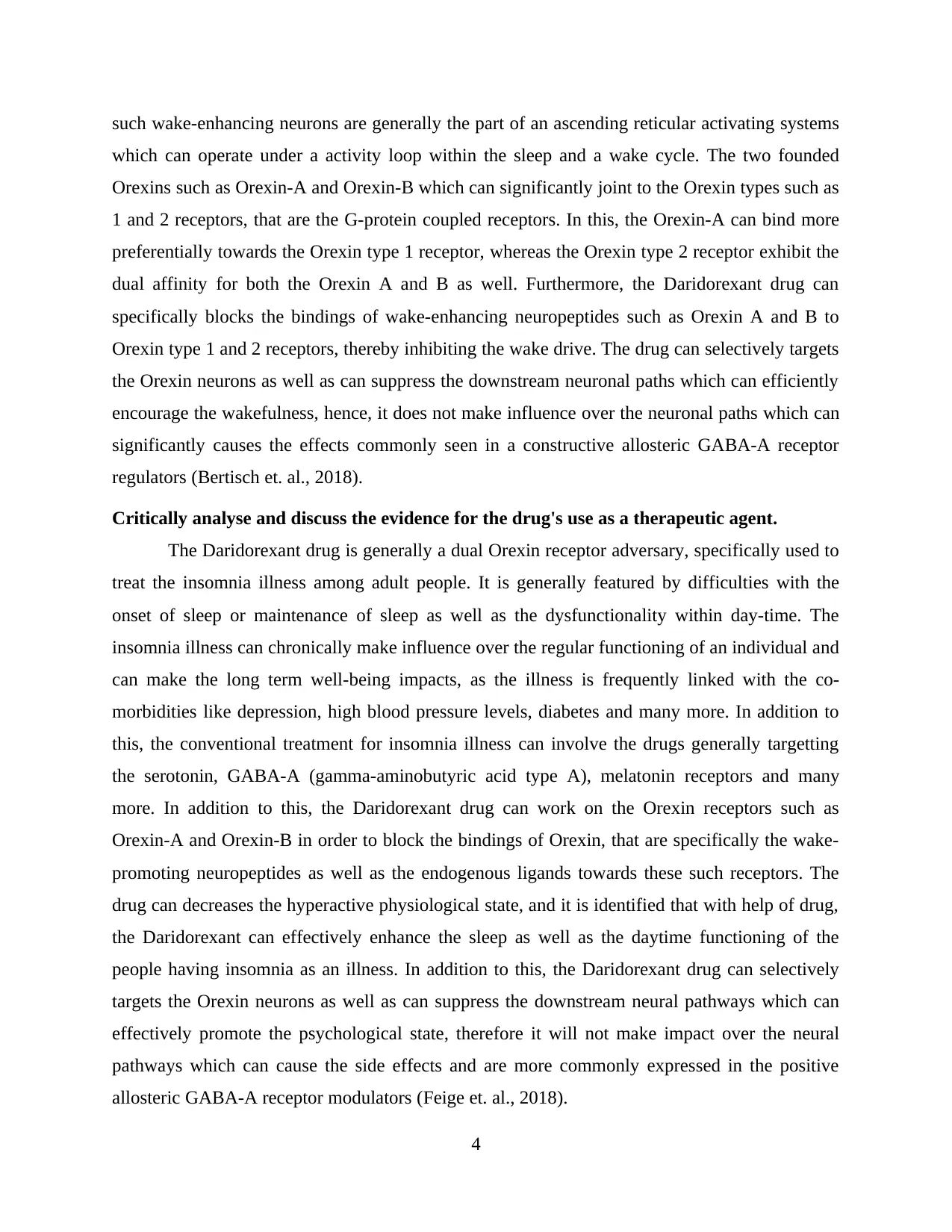
such wake-enhancing neurons are generally the part of an ascending reticular activating systems
which can operate under a activity loop within the sleep and a wake cycle. The two founded
Orexins such as Orexin-A and Orexin-B which can significantly joint to the Orexin types such as
1 and 2 receptors, that are the G-protein coupled receptors. In this, the Orexin-A can bind more
preferentially towards the Orexin type 1 receptor, whereas the Orexin type 2 receptor exhibit the
dual affinity for both the Orexin A and B as well. Furthermore, the Daridorexant drug can
specifically blocks the bindings of wake-enhancing neuropeptides such as Orexin A and B to
Orexin type 1 and 2 receptors, thereby inhibiting the wake drive. The drug can selectively targets
the Orexin neurons as well as can suppress the downstream neuronal paths which can efficiently
encourage the wakefulness, hence, it does not make influence over the neuronal paths which can
significantly causes the effects commonly seen in a constructive allosteric GABA-A receptor
regulators (Bertisch et. al., 2018).
Critically analyse and discuss the evidence for the drug's use as a therapeutic agent.
The Daridorexant drug is generally a dual Orexin receptor adversary, specifically used to
treat the insomnia illness among adult people. It is generally featured by difficulties with the
onset of sleep or maintenance of sleep as well as the dysfunctionality within day-time. The
insomnia illness can chronically make influence over the regular functioning of an individual and
can make the long term well-being impacts, as the illness is frequently linked with the co-
morbidities like depression, high blood pressure levels, diabetes and many more. In addition to
this, the conventional treatment for insomnia illness can involve the drugs generally targetting
the serotonin, GABA-A (gamma-aminobutyric acid type A), melatonin receptors and many
more. In addition to this, the Daridorexant drug can work on the Orexin receptors such as
Orexin-A and Orexin-B in order to block the bindings of Orexin, that are specifically the wake-
promoting neuropeptides as well as the endogenous ligands towards these such receptors. The
drug can decreases the hyperactive physiological state, and it is identified that with help of drug,
the Daridorexant can effectively enhance the sleep as well as the daytime functioning of the
people having insomnia as an illness. In addition to this, the Daridorexant drug can selectively
targets the Orexin neurons as well as can suppress the downstream neural pathways which can
effectively promote the psychological state, therefore it will not make impact over the neural
pathways which can cause the side effects and are more commonly expressed in the positive
allosteric GABA-A receptor modulators (Feige et. al., 2018).
4
which can operate under a activity loop within the sleep and a wake cycle. The two founded
Orexins such as Orexin-A and Orexin-B which can significantly joint to the Orexin types such as
1 and 2 receptors, that are the G-protein coupled receptors. In this, the Orexin-A can bind more
preferentially towards the Orexin type 1 receptor, whereas the Orexin type 2 receptor exhibit the
dual affinity for both the Orexin A and B as well. Furthermore, the Daridorexant drug can
specifically blocks the bindings of wake-enhancing neuropeptides such as Orexin A and B to
Orexin type 1 and 2 receptors, thereby inhibiting the wake drive. The drug can selectively targets
the Orexin neurons as well as can suppress the downstream neuronal paths which can efficiently
encourage the wakefulness, hence, it does not make influence over the neuronal paths which can
significantly causes the effects commonly seen in a constructive allosteric GABA-A receptor
regulators (Bertisch et. al., 2018).
Critically analyse and discuss the evidence for the drug's use as a therapeutic agent.
The Daridorexant drug is generally a dual Orexin receptor adversary, specifically used to
treat the insomnia illness among adult people. It is generally featured by difficulties with the
onset of sleep or maintenance of sleep as well as the dysfunctionality within day-time. The
insomnia illness can chronically make influence over the regular functioning of an individual and
can make the long term well-being impacts, as the illness is frequently linked with the co-
morbidities like depression, high blood pressure levels, diabetes and many more. In addition to
this, the conventional treatment for insomnia illness can involve the drugs generally targetting
the serotonin, GABA-A (gamma-aminobutyric acid type A), melatonin receptors and many
more. In addition to this, the Daridorexant drug can work on the Orexin receptors such as
Orexin-A and Orexin-B in order to block the bindings of Orexin, that are specifically the wake-
promoting neuropeptides as well as the endogenous ligands towards these such receptors. The
drug can decreases the hyperactive physiological state, and it is identified that with help of drug,
the Daridorexant can effectively enhance the sleep as well as the daytime functioning of the
people having insomnia as an illness. In addition to this, the Daridorexant drug can selectively
targets the Orexin neurons as well as can suppress the downstream neural pathways which can
effectively promote the psychological state, therefore it will not make impact over the neural
pathways which can cause the side effects and are more commonly expressed in the positive
allosteric GABA-A receptor modulators (Feige et. al., 2018).
4
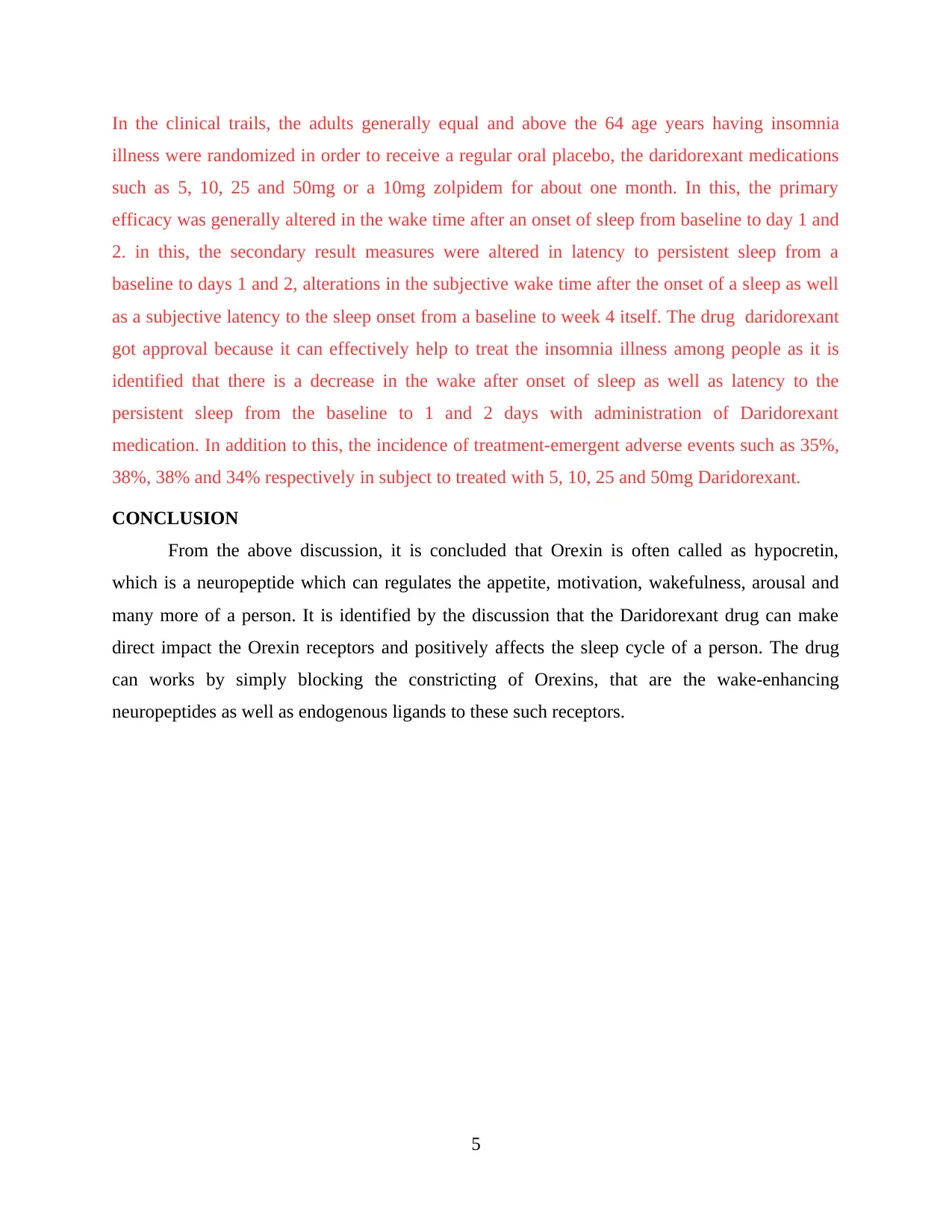
In the clinical trails, the adults generally equal and above the 64 age years having insomnia
illness were randomized in order to receive a regular oral placebo, the daridorexant medications
such as 5, 10, 25 and 50mg or a 10mg zolpidem for about one month. In this, the primary
efficacy was generally altered in the wake time after an onset of sleep from baseline to day 1 and
2. in this, the secondary result measures were altered in latency to persistent sleep from a
baseline to days 1 and 2, alterations in the subjective wake time after the onset of a sleep as well
as a subjective latency to the sleep onset from a baseline to week 4 itself. The drug daridorexant
got approval because it can effectively help to treat the insomnia illness among people as it is
identified that there is a decrease in the wake after onset of sleep as well as latency to the
persistent sleep from the baseline to 1 and 2 days with administration of Daridorexant
medication. In addition to this, the incidence of treatment-emergent adverse events such as 35%,
38%, 38% and 34% respectively in subject to treated with 5, 10, 25 and 50mg Daridorexant.
CONCLUSION
From the above discussion, it is concluded that Orexin is often called as hypocretin,
which is a neuropeptide which can regulates the appetite, motivation, wakefulness, arousal and
many more of a person. It is identified by the discussion that the Daridorexant drug can make
direct impact the Orexin receptors and positively affects the sleep cycle of a person. The drug
can works by simply blocking the constricting of Orexins, that are the wake-enhancing
neuropeptides as well as endogenous ligands to these such receptors.
5
illness were randomized in order to receive a regular oral placebo, the daridorexant medications
such as 5, 10, 25 and 50mg or a 10mg zolpidem for about one month. In this, the primary
efficacy was generally altered in the wake time after an onset of sleep from baseline to day 1 and
2. in this, the secondary result measures were altered in latency to persistent sleep from a
baseline to days 1 and 2, alterations in the subjective wake time after the onset of a sleep as well
as a subjective latency to the sleep onset from a baseline to week 4 itself. The drug daridorexant
got approval because it can effectively help to treat the insomnia illness among people as it is
identified that there is a decrease in the wake after onset of sleep as well as latency to the
persistent sleep from the baseline to 1 and 2 days with administration of Daridorexant
medication. In addition to this, the incidence of treatment-emergent adverse events such as 35%,
38%, 38% and 34% respectively in subject to treated with 5, 10, 25 and 50mg Daridorexant.
CONCLUSION
From the above discussion, it is concluded that Orexin is often called as hypocretin,
which is a neuropeptide which can regulates the appetite, motivation, wakefulness, arousal and
many more of a person. It is identified by the discussion that the Daridorexant drug can make
direct impact the Orexin receptors and positively affects the sleep cycle of a person. The drug
can works by simply blocking the constricting of Orexins, that are the wake-enhancing
neuropeptides as well as endogenous ligands to these such receptors.
5
Paraphrase This Document
Need a fresh take? Get an instant paraphrase of this document with our AI Paraphraser
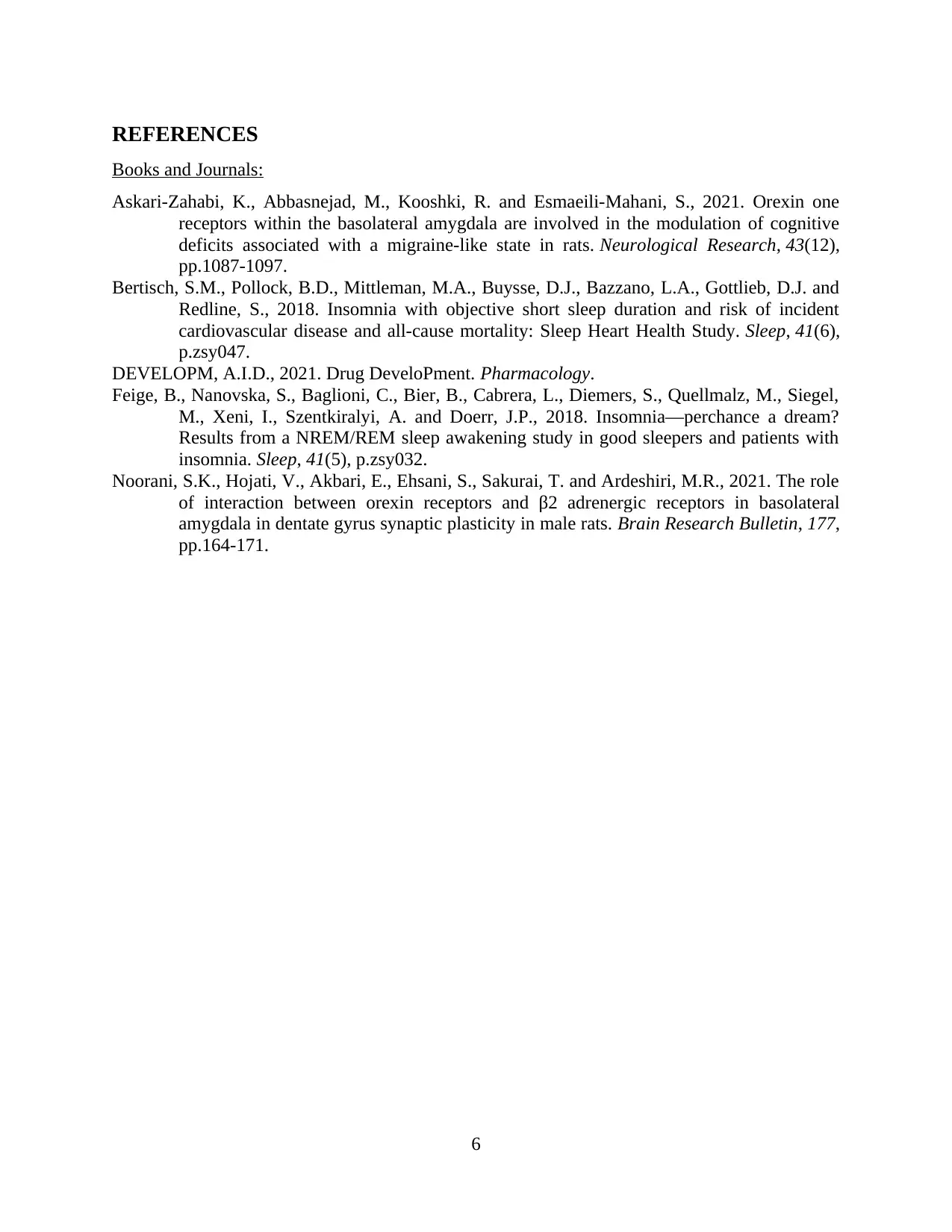
REFERENCES
Books and Journals:
Askari-Zahabi, K., Abbasnejad, M., Kooshki, R. and Esmaeili-Mahani, S., 2021. Orexin one
receptors within the basolateral amygdala are involved in the modulation of cognitive
deficits associated with a migraine-like state in rats. Neurological Research, 43(12),
pp.1087-1097.
Bertisch, S.M., Pollock, B.D., Mittleman, M.A., Buysse, D.J., Bazzano, L.A., Gottlieb, D.J. and
Redline, S., 2018. Insomnia with objective short sleep duration and risk of incident
cardiovascular disease and all-cause mortality: Sleep Heart Health Study. Sleep, 41(6),
p.zsy047.
DEVELOPM, A.I.D., 2021. Drug DeveloPment. Pharmacology.
Feige, B., Nanovska, S., Baglioni, C., Bier, B., Cabrera, L., Diemers, S., Quellmalz, M., Siegel,
M., Xeni, I., Szentkiralyi, A. and Doerr, J.P., 2018. Insomnia—perchance a dream?
Results from a NREM/REM sleep awakening study in good sleepers and patients with
insomnia. Sleep, 41(5), p.zsy032.
Noorani, S.K., Hojati, V., Akbari, E., Ehsani, S., Sakurai, T. and Ardeshiri, M.R., 2021. The role
of interaction between orexin receptors and β2 adrenergic receptors in basolateral
amygdala in dentate gyrus synaptic plasticity in male rats. Brain Research Bulletin, 177,
pp.164-171.
6
Books and Journals:
Askari-Zahabi, K., Abbasnejad, M., Kooshki, R. and Esmaeili-Mahani, S., 2021. Orexin one
receptors within the basolateral amygdala are involved in the modulation of cognitive
deficits associated with a migraine-like state in rats. Neurological Research, 43(12),
pp.1087-1097.
Bertisch, S.M., Pollock, B.D., Mittleman, M.A., Buysse, D.J., Bazzano, L.A., Gottlieb, D.J. and
Redline, S., 2018. Insomnia with objective short sleep duration and risk of incident
cardiovascular disease and all-cause mortality: Sleep Heart Health Study. Sleep, 41(6),
p.zsy047.
DEVELOPM, A.I.D., 2021. Drug DeveloPment. Pharmacology.
Feige, B., Nanovska, S., Baglioni, C., Bier, B., Cabrera, L., Diemers, S., Quellmalz, M., Siegel,
M., Xeni, I., Szentkiralyi, A. and Doerr, J.P., 2018. Insomnia—perchance a dream?
Results from a NREM/REM sleep awakening study in good sleepers and patients with
insomnia. Sleep, 41(5), p.zsy032.
Noorani, S.K., Hojati, V., Akbari, E., Ehsani, S., Sakurai, T. and Ardeshiri, M.R., 2021. The role
of interaction between orexin receptors and β2 adrenergic receptors in basolateral
amygdala in dentate gyrus synaptic plasticity in male rats. Brain Research Bulletin, 177,
pp.164-171.
6
1 out of 8
Related Documents
Your All-in-One AI-Powered Toolkit for Academic Success.
+13062052269
info@desklib.com
Available 24*7 on WhatsApp / Email
![[object Object]](/_next/static/media/star-bottom.7253800d.svg)
Unlock your academic potential
© 2024 | Zucol Services PVT LTD | All rights reserved.





